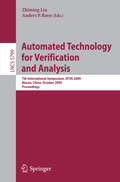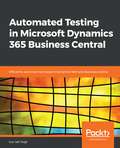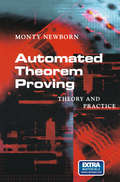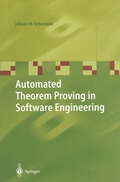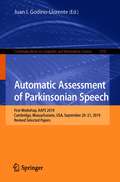- Table View
- List View
Automated Technology for Verification and Analysis: 7th International Symposium, ATVA 2009, Macao, China, October 14-16, 2009, Proceedings (Lecture Notes in Computer Science #5799)
by Zhiming Liu Anders P. RavnThis book constitutes the proceedings of the 7th International Symposium on Automated Technology for Verification and Analysis, ATVA 2009, held in Macao, China, in October 2009. The 23 regular papers and 3 took papers presented together with 3 invited talks, were carefully reviewed and selected from 74 research papers and 10 tool papers submissions. The papers are organized in topical sections on state space reduction, tools, probabilistic systems, medley, temporal logic, abstraction and refinement, and fault tolerant systems.
Automated Technology for Verification and Analysis: 10th International Symposium, ATVA 2012, Thiruvananthapuram, India, October 3-6, 2012, Proceedings (Lecture Notes in Computer Science #7561)
by Madhavan Mukund Supratik ChakrabortyThis book constitutes the thoroughly refereed proceedings of the 10th International Symposium on Automated Technology for Verification and Analysis, ATVA 2012, held at Thiruvananthapuram, Kerala, India, in October 2012. The 25 regular papers, 3 invited papers and 4 tool papers presented were carefully selected from numerous submissions. Conference papers are organized in 9 technical sessions, covering the topics of automata theory, logics and proofs, model checking, software verification, synthesis, verification and parallelism, probabilistic verification, constraint solving and applications, and probabilistic systems.
Automated Technology for Verification and Analysis: 5th International Symposium, ATVA 2007 Tokyo, Japan, October 22-25, 2007 Proceedings (Lecture Notes in Computer Science #4762)
by Kedar Namjoshi Tomohiro Yoneda Teruo Higashino Yoshio OkamuraThis book constitutes the refereed proceedings of the 5th International Symposium on Automated Technology for Verification and Analysis, ATVA 2007. The 29 revised full papers presented together with seven short papers address theoretical methods to achieve correct software or hardware systems, including both functional and non functional aspects; as well as applications of theory in engineering methods and particular domains and handling of practical problems occurring in tools.
Automated Technology for Verification and Analysis: Third International Symposium, ATVA 2005, Taipei, Taiwan, October 4-7, 2005, Proceedings (Lecture Notes in Computer Science #3707)
by Doron A. Peled Yih-Kuen TsayThe Automated Technology for Veri?cation and Analysis (ATVA) international symposium series was initiated in 2003, responding to a growing interest in formal veri?cation spurred by the booming IT industry, particularly hardware design and manufacturing in East Asia. Its purpose is to promote research on automated veri?cation and analysis in the region by providing a forum for int- action between the regional and the international research/industrial commu- ties of the ?eld. ATVA 2005, the third of the ATVA series, was held in Taipei, Taiwan, October 4–7, 2005. The main theme of the symposium encompasses - sign, complexities, tools, and applications of automated methods for veri?cation and analysis. The symposium was co-located and had a two-day overlap with FORTE 2005, which was held October 2–5, 2005. We received a total of 95 submissions from 17 countries. Each submission was assigned to three Program Committee members, who were helped by their subreviewers, for rigorous and fair evaluation. The ?nal deliberation by the P- gram Committee was conducted over email for a duration of about 10 days after nearly all review reports had been collected. In the end, 33 papers were - lectedforinclusionintheprogram.ATVA2005hadthreekeynotespeechesgiven respectively by Amir Pnueli (joint with FORTE 2005), Zohar Manna, and Wo- gang Thomas. The main symposium was preceded by a tutorial day, consisting of three two-hour lectures given also by the keynote speakers.
Automated Technology for Verification and Analysis: Second International Conference, ATVA 2004, Taipei, Taiwan, ROC, October 31 - November 3, 2004. Proceedings (Lecture Notes in Computer Science #3299)
by Farn WangAutomated Testing in Microsoft Dynamics 365 Business Central: Efficiently Automate Test Cases In Dynamics Nav And Business Central
by Luc Van VugtDynamics 365 Business Central is the new Cloud-based SaaS ERP proposition from Microsoft. It’s not as simple as it used to be way back when it was called Navigator, Navision Financials, or Microsoft Business Solutions-Navision. Our development practices are becoming more formal, and with this the call for test automation is pressing on us. This book will teach you to leverage testing tools available with Dynamics 365 Business Central to perform automated testing.
Automated Theorem Proving: Theory and Practice
by Monty NewbornThis text and software package introduces readers to automated theorem proving, while providing two approaches implemented as easy-to-use programs. These are semantic-tree theorem proving and resolution-refutation theorem proving. The early chapters introduce first-order predicate calculus, well-formed formulae, and their transformation to clauses. Then the author goes on to show how the two methods work and provides numerous examples for readers to try their hand at theorem-proving experiments. Each chapter comes with exercises designed to familiarise the readers with the ideas and with the software, and answers to many of the problems.
Automated Theorem Proving in Software Engineering
by Johann M. SchumannGrowing demands for the quality, safety, and security of software can only be satisfied by the rigorous application of formal methods during software design. This book methodically investigates the potential of first-order logic automated theorem provers for applications in software engineering. Illustrated by complete case studies on protocol verification, verification of security protocols, and logic-based software reuse, this book provides techniques for assessing the prover's capabilities and for selecting and developing an appropriate interface architecture.
Automated Theorem Proving: A Logical Basis (Fundamental Studies in Computer Science #1)
by D.W. LovelandAutomated Theorem Proving: A Logical Basis
Automated Theory Formation in Pure Mathematics (Distinguished Dissertations)
by Simon ColtonIn recent years, Artificial Intelligence researchers have largely focused their efforts on solving specific problems, with less emphasis on 'the big picture' - automating large scale tasks which require human-level intelligence to undertake. The subject of this book, automated theory formation in mathematics, is such a large scale task. Automated theory formation requires the invention of new concepts, the calculating of examples, the making of conjectures and the proving of theorems. This book, representing four years of PhD work by Dr. Simon Colton demonstrates how theory formation can be automated. Building on over 20 years of research into constructing an automated mathematician carried out in Professor Alan Bundy's mathematical reasoning group in Edinburgh, Dr. Colton has implemented the HR system as a solution to the problem of forming theories by computer. HR uses various pieces of mathematical software, including automated theorem provers, model generators and databases, to build a theory from the bare minimum of information - the axioms of a domain. The main application of this work has been mathematical discovery, and HR has had many successes. In particular, it has invented 20 new types of number of sufficient interest to be accepted into the Encyclopaedia of Integer Sequences, a repository of over 60,000 sequences contributed by many (human) mathematicians.
Automated Trading with R: Quantitative Research and Platform Development
by Chris ConlanLearn to trade algorithmically with your existing brokerage, from data management, to strategy optimization, to order execution, using free and publicly available data. Connect to your brokerage’s API, and the source code is plug-and-play.Automated Trading with R explains automated trading, starting with its mathematics and moving to its computation and execution. You will gain a unique insight into the mechanics and computational considerations taken in building a back-tester, strategy optimizer, and fully functional trading platform.The platform built in this book can serve as a complete replacement for commercially available platforms used by retail traders and small funds. Software components are strictly decoupled and easily scalable, providing opportunity to substitute any data source, trading algorithm, or brokerage. This book will:Provide a flexible alternative to common strategy automation frameworks, like Tradestation, Metatrader, and CQG, to small funds and retail tradersOffer an understanding of the internal mechanisms of an automated trading systemStandardize discussion and notation of real-world strategy optimization problemsWhat You Will LearnUnderstand machine-learning criteria for statistical validity in the context of time-seriesOptimize strategies, generate real-time trading decisions, and minimize computation time while programming an automated strategy in R and using its package libraryBest simulate strategy performance in its specific use case to derive accurate performance estimatesUnderstand critical real-world variables pertaining to portfolio management and performance assessment, including latency, drawdowns, varying trade size, portfolio growth, and penalization of unused capitalWho This Book Is ForTraders/practitioners at the retail or small fund level with at least an undergraduate background in finance or computer science; graduate level finance or data science students
Automated Unit Testing with ABAP: A Practical Approach
by James E. McDonoughWrite automated unit tests for the ABAP language. This book teaches programmers using simple examples and metaphors and explains the underlying concepts of writing effective automated unit tests. Many, if not most, ABAP programmers learned their programming and testing skills before the ABAP development environment provided an automated unit testing facility. Automated Unit Testing with ABAP: A Practical Approach offers hope and salvation to ABAP programmers who continue to toil with antiquated manual unit testing processes, taking them by the hand and lifting them out of that dungeon of despair with a modern and proven alternative. It begins by explaining how the xUnit family of automated testing frameworks provides a quick and effective means of insuring high-quality software. It then focuses on the ABAP Unit Testing Facility, the xUnit framework applicable specifically to the ABAP language, showing how it can be used to bring ABAP applications under automated testing control, from old legacy applications to those newly written.Whereas xUnit testing has been widely accepted with developers writing in many other programming languages, it is an unfortunate fact in the ABAP community that many programmers still are unfamiliar with xUnit concepts and do not know how to begin implementing automated unit testing into their development process. This book demonstrates how to refactor programs so they become designed for testability, showing how to use process encapsulation and test isolation to facilitate automated testing, including a thorough explanation of test-driven development and the use of test doubles. The book: Shows how to write automated unit tests for ABAPInstills ABAP programmers with the confidence to refactor poorly written codeExplains how an automated testing harness facilitates rapid software developmentTeaches how to utilize test-driven development (TDD) with ABAPOffers advice and tips on the best ways to write automated unit tests What You Will Learn Become familiar with the xUnit approach to testingKnow the ABAP statements that interfere with running automated unit tests and how to accommodate themUnderstand what it means to isolate code for testing and how this is achievedGain the confidence to refactor poorly written codeMake ABAP programs designed for testabilityReap the benefits of spending less time manually unit testing ABAP programsUse test-driven development (TDD) with ABAP programmingUse configurable test doubles in ABAP Who This Book Is ForABAP programmers who remain unfamiliar with the automated unit testing facility and those who already use it but want to improve their skill writing and using automated tests. The book addresses the reluctance and trepidation felt by procedural ABAP programmers who need to know some object-oriented concepts to use this facility, expands their horizons, and helps them step through the doorway leading to a different approach to program design.
Automated Validation & Verification of UML/OCL Models Using Satisfiability Solvers
by Nils Przigoda Robert Wille Judith Przigoda Rolf DrechslerThis book provides a comprehensive discussion of UML/OCL methods and design flow, for automatic validation and verification of hardware and software systems. While the presented flow focuses on using satisfiability solvers, the authors also describe how these methods can be used for any other automatic reasoning engine. Additionally, the design flow described is applied to a broad variety of validation and verification tasks. The authors also cover briefly how non-functional properties such as timing constraints can be handled with the described flow.
Automated Verification of Concurrent Search Structures (Synthesis Lectures on Computer Science)
by Krishna Siddharth Patel Nisarg Shasha Dennis Wies ThomasSearch structures support the fundamental data storage primitives on key-value pairs: insert a pair, delete by key, search by key, and update the value associated with a key. Concurrent search structures are parallel algorithms to speed access to search structures on multicore and distributed servers. These sophisticated algorithms perform fine-grained synchronization between threads, making them notoriously difficult to design correctly. Indeed, bugs have been found both in actual implementations and in the designs proposed by experts in peer-reviewed publications. The rapid development and deployment of these concurrent algorithms has resulted in a rift between the algorithms that can be verified by the state-of-the-art techniques and those being developed and used today. The goal of this book is to show how to bridge this gap in order to bring the certified safety of formal verification to high-performance concurrent search structures. Similar techniques and frameworks can be applied to concurrent graph and network algorithms beyond search structures.
Automated Web Site Evaluation: Researchers’ and Practioners’ Perspectives (Human–Computer Interaction Series #4)
by M.Y. IvoryAmong all information systems that are nowadays available, web sites are definitely the ones having the widest potential audience and the most significant impact on the everyday life of people. Web sites contribute largely to the information society: they provide visitors with a large array of services and information and allow them to perform various tasks without prior assumptions about their computer literacy. Web sites are assumed to be accessible and usable to the widest possible audience. Consequently, usability has been recognized as a critical success factor for web sites of every kind. Beyond this universal recognition, usability still remains a notion that is hard to grasp. Summative evaluation methods have been introduced to identify potential usability problems to assess the quality of web sites. However, summative evaluation remains limited in impact as it does not necessarily deliver constructive comments to web site designers and developers on how to solve the usability problems. Formative evaluation methods have been introduced to address this issue. Evaluation remains a process that is hard to drive and perform, while its potential impact is probably maximal for the benefit of the final user. This complexity is exacerbated when web sites are very large, potentially up to several hundreds of thousands of pages, thus leading to a situation where eval uating the web site is almost impossible to conduct manually. Therefore, many attempts have been made to support evaluation with: • Models that capture some characteristics of the web site of interest.
Automated Workflow Scheduling in Self-Adaptive Clouds: Concepts, Algorithms and Methods (Computer Communications and Networks)
by G. Kousalya P. Balakrishnan C. Pethuru RajThis timely text/reference presents a comprehensive review of the workflow scheduling algorithms and approaches that are rapidly becoming essential for a range of software applications, due to their ability to efficiently leverage diverse and distributed cloud resources. Particular emphasis is placed on how workflow-based automation in software-defined cloud centers and hybrid IT systems can significantly enhance resource utilization and optimize energy efficiency.Topics and features: describes dynamic workflow and task scheduling techniques that work across multiple (on-premise and off-premise) clouds; presents simulation-based case studies, and details of real-time test bed-based implementations; offers analyses and comparisons of a broad selection of static and dynamic workflow algorithms; examines the considerations for the main parameters in projects limited by budget and time constraints; covers workflow management systems, workflow modeling and simulation techniques, and machine learning approaches for predictive workflow analytics. This must-read work provides invaluable practical insights from three subject matter experts in the cloud paradigm, which will empower IT practitioners and industry professionals in their daily assignments. Researchers and students interested in next-generation software-defined cloud environments will also greatly benefit from the material in the book.
Automatic Algorithm Selection for Complex Simulation Problems
by Roland EwaldTo select the most suitable simulation algorithm for a given task is often difficult. This is due to intricate interactions between model features, implementation details, and runtime environment, which may strongly affect the overall performance. An automated selection of simulation algorithms supports users in setting up simulation experiments without demanding expert knowledge on simulation. Roland Ewald analyzes and discusses existing approaches to solve the algorithm selection problem in the context of simulation. He introduces a framework for automatic simulation algorithm selection and describes its integration into the open-source modelling and simulation framework James II. Its selection mechanisms are able to cope with three situations: no prior knowledge is available, the impact of problem features on simulator performance is unknown, and a relationship between problem features and algorithm performance can be established empirically. The author concludes with an experimental evaluation of the developed methods.
Automatic Analog IC Sizing and Optimization Constrained with PVT Corners and Layout Effects
by Nuno Lourenço Ricardo Martins Nuno HortaThis book introduces readers to a variety of tools for automatic analog integrated circuit (IC) sizing and optimization. The authors provide a historical perspective on the early methods proposed to tackle automatic analog circuit sizing, with emphasis on the methodologies to size and optimize the circuit, and on the methodologies to estimate the circuit’s performance. The discussion also includes robust circuit design and optimization and the most recent advances in layout-aware analog sizing approaches. The authors describe a methodology for an automatic flow for analog IC design, including details of the inputs and interfaces, multi-objective optimization techniques, and the enhancements made in the base implementation by using machine leaning techniques. The Gradient model is discussed in detail, along with the methods to include layout effects in the circuit sizing. The concepts and algorithms of all the modules are thoroughly described, enabling readers to reproduce the methodologies, improve the quality of their designs, or use them as starting point for a new tool. An extensive set of application examples is included to demonstrate the capabilities and features of the methodologies described.
Automatic Assessment of Parkinsonian Speech: First Workshop, AAPS 2019, Cambridge, Massachussets, USA, September 20–21, 2019, Revised Selected Papers (Communications in Computer and Information Science #1295)
by Juan I. Godino-LlorenteThis book constitutes the revised and extended papers of the First Automatic Assessment of Parkinsonian Speech Workshop, AAPS 2019, held in Cambridge, Massachusetts, USA, in September 2019. The 6 full papers were thoroughly reviewed and selected from 15 submissions. They present recent research on the automatic assessment of parkinsonian speech from the point of view of such disciplines as machine learning, speech technology, phonetics, neurology, and speech therapy
Automatic Autocorrelation and Spectral Analysis
by Petrus M.T. BroersenSpectral analysis requires subjective decisions which influence the final estimate and mean that different analysts can obtain different results from the same stationary stochastic observations. Statistical signal processing can overcome this difficulty, producing a unique solution for any set of observations but that is only acceptable if it is close to the best attainable accuracy for most types of stationary data. This book describes a method which fulfils the above near-optimal-solution criterion, taking advantage of greater computing power and robust algorithms to produce enough candidate models to be sure of providing a suitable candidate for given data.
Automatic Calibration and Reconstruction for Active Vision Systems (Intelligent Systems, Control and Automation: Science and Engineering #57)
by Beiwei Zhang Y. F. LiIn this book, the design of two new planar patterns for camera calibration of intrinsic parameters is addressed and a line-based method for distortion correction is suggested. The dynamic calibration of structured light systems, which consist of a camera and a projector is also treated. Also, the 3D Euclidean reconstruction by using the image-to-world transformation is investigated. Lastly, linear calibration algorithms for the catadioptric camera are considered, and the homographic matrix and fundamental matrix are extensively studied. In these methods, analytic solutions are provided for the computational efficiency and redundancy in the data can be easily incorporated to improve reliability of the estimations. This volume will therefore prove valuable and practical tool for researchers and practioners working in image processing and computer vision and related subjects.
Automatic Control and Emerging Technologies: Proceedings of ACET 2023 (Lecture Notes in Electrical Engineering #1141)
by Hassan El Fadil Weicun ZhangThis book contains the original, peer-reviewed research papers from the International Symposium on Automatic Control and Emerging Technologies, held in Kenitra, Morrocco, on July 11-13, 2023. The topics covered include but are not limited to: System Identification, Linear/Nonlinear Control Systems, Data-driven Modelling and Control, Process Modelling and Process Control, Fault Diagnosis and Reliable Control, Intelligent Systems, and Machine Learning and Artificial Intelligence.The papers showcased here share the latest findings on topics with potential for academic research and industrial applications, making the book a valuable resource for researchers, engineers, and university students alike.
Automatic Control Systems: With MATLAB
by S. PalaniThis book is designed to serve as a textbook for courses offered to undergraduate students enrolled in Electrical Engineering and related disciplines. The book provides a comprehensive coverage of linear system theory. In this book, the concepts around each topic are well discussed with a full-length presentation of numerical examples. Each example is unique in its way, and it is graded sequentially. This book highlights simple methods for solving problems. Even though, the subject requires a very strong mathematical foundation, wherever possible, rigorous mathematics is simplified for a quick understanding of the basic concepts. The book also includes select numerical problems to test the capability of the students. Time and frequency domain approaches for the analysis and design of linear automatic control systems have been explained using state-space and transfer function models of physical systems. All the chapters include a short theoretical summary of the topic followed by exercises on solving complex problems using MATLAB commands. In addition, each chapter offers a large number of end-of-chapter homework problems. This second edition includes a new chapter on state-space modeling and analysis. Detailed conceptual coverage and pedagogical tools make this an ideal textbook for students and researchers enrolled in electrical engineering and related programs.
Automatic Control Systems in Biomedical Engineering: An Interactive Educational Approach
by J. Fernández de Cañete C. Galindo J. Barbancho A. LuqueThis book presents the fundamental principles and challenges encountered in the control of biomedical systems, providing practical solutions and suggesting alternatives. The perspective of the text is based on the system behaviour in the time domain both linear and non-linear, continuous and discrete, helping the reader to be able to interpret the physical significance of mathematical results during control system analysis and design focusing on biomedical engineering applications. Interactive learning is promoted, endowing students with the ability to change parameters and conditions during the simulation and see the effects of these changes, by using interactive MATLAB and SIMULINK software tools, also presenting realistic problems in order to analyse, design and develop automatic control systems. The text is also complemented with MATLAB and SIMULINK exercise files solved to aid students to focus on the fundamental concepts treated throughout the book, following a new pedagogical approach distinct from the classical one whereby fundamental control concepts are introduced together with adequate software tools in order to gain insight on the biomedical engineering control problems. The book is suitable for second or third-year undergraduate students who will find the illustrative examples particularly useful to their studies of control system design and implementation. Lecturers in the control field will find the computer aided design approach as an alternative to teaching the fundamental concepts of feedback analogic and digital control.
